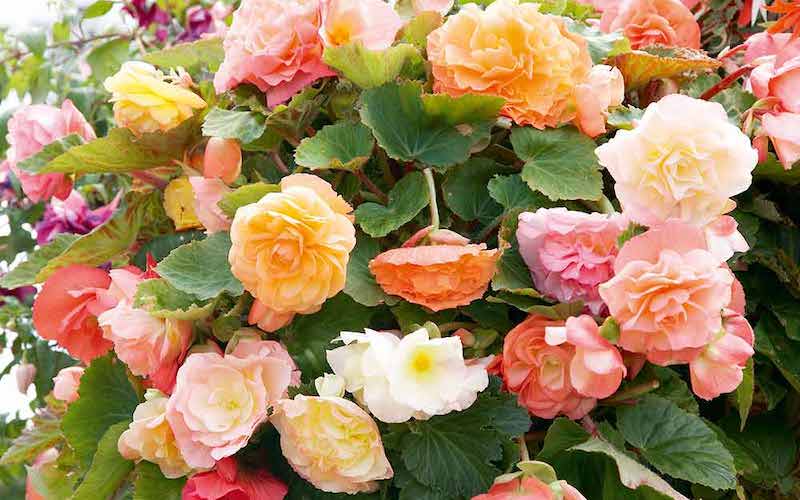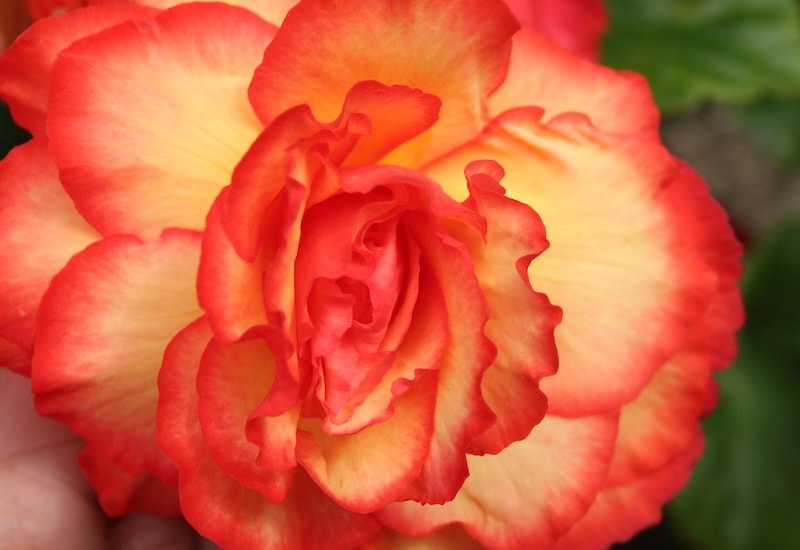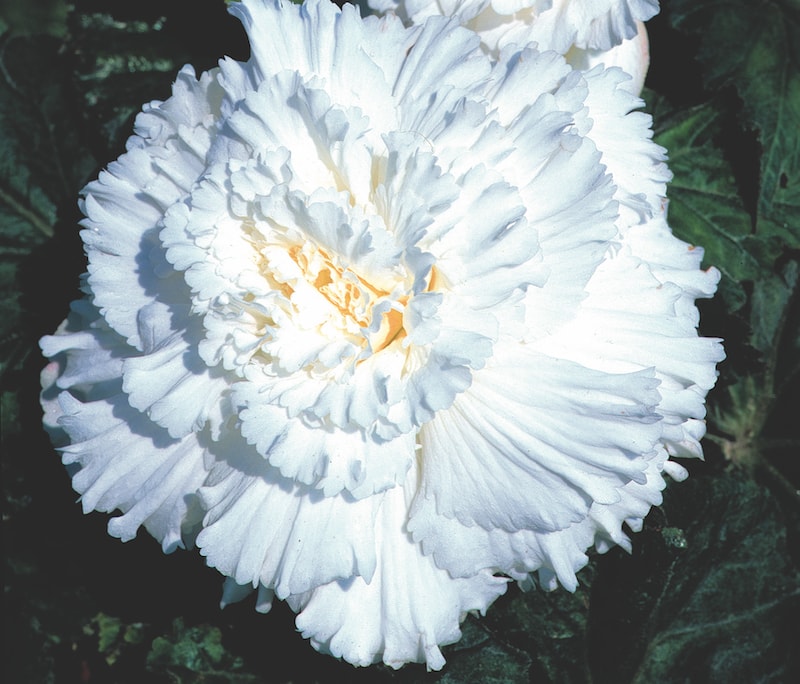You can plant begonia tubers or grow them from seed, but if you want to know how to get the most beautiful blooms, start with this collection of carefully curated content from the internet. These articles, videos and Instagram posts have been created by those who know begonias best – professional gardeners and experienced enthusiasts. With just a few helpful tips from these experts, you’ll soon be growing award-winning begonias in your own garden.
Contents
- Best advice on growing begonias from tubers or seed
- Best advice on how to overwinter begonias
- Best advice on begonia care and pests
- Best advice on begonia houseplants
- Best begonias to grow in hanging baskets, pots and borders
Best advice on growing begonias from tubers or seed

Copyright: Visions BV, Netherlands
Patient Gardener Daniel likes to give his begonia tubers a head start indoors. He gets them going in March, ready to move them outside once all chance of frost has passed. But don’t plant them too deeply, he says, and take care to get them the right way up. “You want to look for a little dip in the tuber. This is the top.”
At Pyracantha, John Moore also starts his tubers off indoors. He says, “within a few weeks, you should see buds emerging, and once you see 3cm shoots…rub away all but the strongest three.” As the buds continue to grow, John gradually adds compost one centimetre at a time until it reaches the top of the pot. At that point, he gives them a shot of liquid tomato fertilizer for a quick boost. Read his full growing begonias article for more excellent tips.
Adam makes it look super easy as he plants begonia corms in this short video guide at Allotment Grow How. The secret, according to Adam, is not letting any moisture get inside the corm which could cause it to rot. He times it so that his begonias go into their pots about six weeks before the last frost, ready to be hardened off and planted out at the end of May.
Most people grow begonias from tubers or buy trays of plug plants, but some varieties can be grown successfully from seed, as Daniel, Patient Gardener, confirms in his article: How to sow begonia seeds. He recommends sifting the soil and watering it before you sprinkle the tiny seeds on the surface. Don’t cover them with compost, as they need lots of light to germinate.
Best advice on how to overwinter begonias

Copyright: Customer – Derrick Turbitt
According to James Middleton of The Allotment Garden: “Although often sold as half-hardy annuals, most begonias are actually perennials. However, they’re not at all frost hardy.” He overwinters his tuberous rooted begonias in old hanging baskets in his garden shed, but he says that any cool, dark and dry place will do. Fibrous rooted begonias, on the other hand, need to be pruned and taken indoors. See his full step-by-step guide to overwintering begonias for more excellent tips.
“[Leafy] begonias really do hate central heating,” says Jack of Jack Wallington Garden Design. He’s tried to bring them indoors to overwinter as houseplants, but not many survive. Instead, his preferred method is to take leaf cuttings from his favourites. It’s “a fun and easy method of growing lots of begonias in miniature form through winter, ready to plant up and grow en masse in spring,” says Jack.
Once the frosts arrive, you need to lift your tuberous begonias, says Peter Seabrook in his excellent video over on GardenDotHelp. Watch how he carefully removes the soil from his tubers so as not to damage their skins. He takes the opportunity to check for vine weevil while he’s at it. Just take a look at the huge tubers Peter stores in paper bags until next spring.
Over at Allotment Grow How, Adam helps his father save his favourite begonia corms. Simply snapping off the stems, Adam’s video demonstrates how he finds the tubers, wraps them in fleece, and stores them in the greenhouse until spring. The largest begonia corms can be divided to form two new plants, says Adam.
Best advice on begonia care and pests

Image: Begonia tubers ‘Prima Donna White’ from Suttons
If you want a colourful display of blooms for the entire summer, the best time to fill your hanging baskets with begonias is late spring. The Suttons horticultural team recommends adding water storing crystals to the compost. Watch this practical video for more top tips on caring for hanging baskets.
If your begonia tubers get really big, you can divide them to create new plants, says Daniel of Patient Gardener. “Just be aware though, that new, smaller tubers will not provide as many flowers as older larger tubers will,” he warns. If you want to have a go, read Daniel’s full article on how to divide begonias before you start.
The two biggest threats to begonias are vine weevil and mildew, says Peter Seabrook of GardenDotHelp. If you bring your begonias indoors in the winter, you might get an unattractive white powdery growth across all the leaves. It can be treated, but to prevent it happening in the first place, keep your plants moist. Watch Peter’s video on how to treat mildew for more helpful advice.
Best advice on begonia houseplants

Image: Begonia ‘Fireworks’ from Suttons
If you love houseplants, Jack at Jack Wallington Garden Design says that his own indoor begonias were transformed when he moved them to larger pots. “I switched all of my plants up to 20cm pots and sure enough, they’ve grown so much better, developing happily into substantial plants over one summer,” he says. Don’t miss his compost, feeding and watering tips too.
Over @tracys_tropical_plants, Tracy Walton shares a gorgeous image of her recently repotted indoor begonia maculata. “The red leaves look beautiful between green foliage plants. Brings a bit of colour into your home,” she says. Check out her gorgeous feed for some truly tropical greenery.
In the space of just 12 months, Geoff’s indoor begonias have grown from small plugs to good sized houseplants with lots of healthy foliage. Showing before and after images of his begonia Rex, he explains that getting the right temperature is key to success. They don’t like to be in direct sun either. Visit Geoff’s YouTube channel, GROW UP MAN! to check out his begonia ‘Curly Fireflush’ and other Rex varieties.
Best begonias to grow in hanging baskets, pots and borders

Image: Begonia ‘Illumination Apricot Shades’ from Suttons
Michael Perry of Mr Plant Geek says: “If there’s one plant that’s perfect for a hanging basket…it’s Begonia Illumination.” Available in eight colours, and suitable for part shade, Michael says, “this is a delightfully buxom plant with a trailing habit that will tumble over the sides of your baskets in a waterfall of beautiful begonia flowers!” What’s not to love?
If you’re looking for standout window boxes, Begonia ‘Apricot Shades Enhanced’ is what Phoebe recommends over @shegrowsawildgarden. Bought as tiny plugs, not only did they thrive in her garden, she left them in situ over winter and they came back even bigger and better the next year. “I think the fact that this part of the garden is sheltered and keeps warm because of the bricks really helps them.” Visit her post to see for yourself.
Over at Garden Ruminations, Jim has plenty of experience growing begonias. For something really special, he plants Begonia luxurians outside in the borders. “This fabulously architectural plant has absolutely thrived on this treatment though it is killed completely by the first significant frost.” However, not all is lost, explains Jim, as “it’s very easy to grow from cuttings and small plants are easily overwintered to start the cycle again.”
We hope we’ve answered many of your begonia growing questions and inspired you to try some new varieties. Take a look at our full range of begonia tubers here, or add a few garden-ready begonias to your basket if you want instant impact.
Lead image: Begonia Nonstop Mocca Mix from Suttons
Last Updated on November 8, 2024 by Suttons Horticultural Team





